Lettuce
Lettuce is a very sturdy plant, and that makes it easy to grow. We used to start 10 to 15 seeds in a two-inch pot and then would tease them apart when it was time to plant them in the garden. We would get 8 to 10 usable seedlings from each pot, and although their roots were pretty skimpy after having been pulled apart, most all of them would thrive.
Now we've begun using 6-packs to start lettuce. We put only two or three seeds in a cell, then snip off all but one. We expect that will give our lettuce plants a better start and result in edible lettuce sooner.
One downside of lettuce is that we know of no way to store it. Extra spinach, excess greens, two much squash, too many peppers or tomatoes can be stored for later in the year. But lettuce has to be managed so that it can be eaten when it's ready. Our main technique for that is eating huge salads in the summer.
Winter lettuce
One winter we tried growing lettuce under lights in our cellar. The experiment was a success! We eventually had four trays of lettuce plants, one of which was started later than the others. Between the first harvest in early December and a harvest at the end of March (when we harvested the last lettuce from two of the trays) we had a little over three pounds of lettuce.
While this does not sound like much, it provided fifteen meals for the two of us, generally using a total of about 3 ounces in our two salads. We often added sardines (in oil) to the lettuce and a few other amendments (carrots or feta cheese) and that was the basis of lunch.
Over 4 ½ months we used about one kWh of electricity for the lights each day, which would be about $15 in electricity. The light was from two inexpensive Home Depot fluorescent fixtures (T8s not T12s). They were connected to a timer that was on twelve hours each day.
Here's how we harvest the lettuce. We just snip the whole plant off with scissors. Each plant regrew about 4 times.
All the lettuce might have lasted beyond the end of March but we were away for ten days in early March. Two of the trays were under good lighting and covered with plastic to hold in moisture, but the other two, because we had other seedlings starting, were under my old T12, rather dim, fixture, without plastic covering. They just didn't do well—not enough light and not enough moisture.
We replaced that fixture but we needed the space for starting other seedlings. At that point in the year, though, we soon were able to harvest lettuce from the cold frame in the garden.
Cold frame lettuce
Each October for about five years we have been planting lettuce seedlings in a wooden frame with a glass cover and letting them sit unattended over the winter.
When the snow is gone, we remove the cover and let the lettuce plants start growing again.
Some years we have an excellent spring crop, but other years we don't.
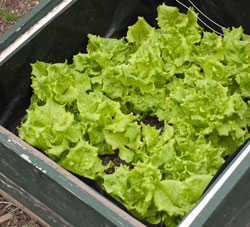 ©Janet Allen
©Janet Allen Lettuce in March
When it works, we have many large salads early in the spring and for many weeks.
And when it doesn't work? There could be many reasons. One year we think the seedlings were too small to survive—that is, we planted too late. Another year November was quite warm and the frame became a feasting area for slugs. One year, it was a tough winter and about half the plants died, had been eaten, or somehow had not survived.
More often than not, though, it's successful, and there's nothing to lose by doing this every year. It can be a really nice, early start to eating from your garden.
Harvest record
| YR | LB | Notes |
| 15 | ||
| 14 | 14 | |
| 13 | 19 | · |
| 12 | 12 | · |
| 11 | 19 | · |
| 10 | 22 | We had a nice early crop from the overwintered lettuce in the cold frame |
| 09 | 13 | · |

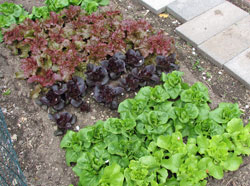 (Enlarge)
(Enlarge)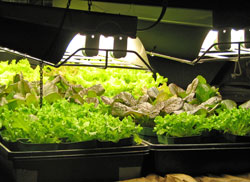 (Enlarge)
(Enlarge)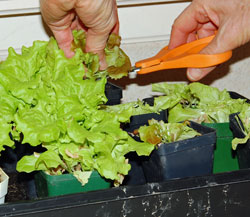 (Enlarge)
(Enlarge)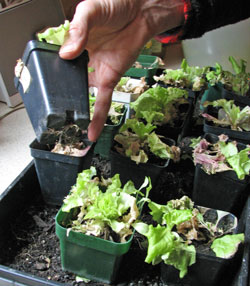 (Enlarge)
(Enlarge)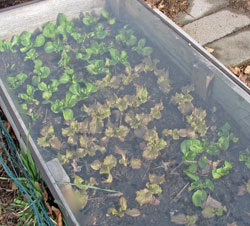 (Enlarge)
(Enlarge)